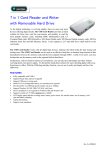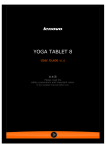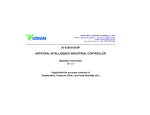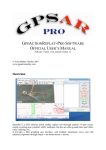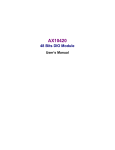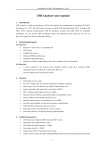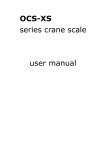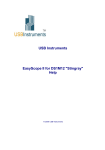Download AI-208 Manual
Transcript
www.instrumentsolutions.com.au ARTIFICIAL INTELLIGENCE TEMPERATURE CONTROLLER AI-208 (V7.6) User Manual www.instrumentsolutions.com.au I. Model Code Symbol The type of AI-208 is made up of 4 parts: AI-208 A G L2 Part 1 (Series) Part 2 (Size) Part 3 (Oupt) Part 4 (AUX) 1. (Part 1) Model Series AI-208, standard temperature controller , 0.3%FS±1℃ accuracy. Multiple thermocouples and RTDs are selectable Suitable for 0~999℃ application. Maximum support two alarms contact output Universal voltage input (100~240VAC) 2. (Part 2) Front panel dimension Front Panel Cut Out width×height width×height A 96×96mm 92×92mm 100mm B 160×80mm 152×76mm 100mm D 72×72mm 68×68mm 95mm D2 48×48mm 45×45mm 95mm E 48×96mm 45×92mm 100mm F 96×48mm 92×45mm 100mm Size Depth Behind Mounting Surface www.instrumentsolutions.com.au 3. (Part 3 and 4) indicate the module installed in OUTP and AUX sockets. Allowed modules in each socket are as below: Allowed Type N L L1 L5 G Module Socket √ 3. OUTP (main output) √ 4. AUX (Auxiliary output) √ √ √ N (or none) no module installed L Relay contact output module (Capacity: 5A/250VAC, normal open) L1 Relay contact output module (Capacity: 2A/250VAC, normal open/ normal close) L5 Dual relay output module Output module (Capacity: 2A/250VAC, normal open, support AU1 and AU2 alarm output) G SSR voltage output module (30mA/5VDC) II. TECHNICAL SPECIFICATION 1. Input type : Thermocouple: K, E, J, N Resistance temperature detector: Pt100 2. Instrument Input range : K, E, J, N : (0~+999)℃ ; Pt100: (0~+800)℃ 3. Measurement accuracy : 0.3%FS±1℃ 4. Temperature display resolution : 0 or 0.0 (0.0 just for 0~99.9 display) 5. Control mode: On-off control mode, or PID control with the function of parameter auto tuning. 6. Alarm function: High limit alarm, Lower limit alarm, Deviation High Alarm; providing the function of alarm blocking at the beginning of power on. 7. Power supply voltage rating: 100-240VAC, -15%, +10% / 50-60Hz. 8. Power consumption: ≤2W 9. Ambient temperature: -10~+60℃, Humidity: 0~90RH% www.instrumentsolutions.com.au III. FRONT PANEL AND OPERATION ① Process Value(PV), or parameter code ② Set Value(SV), alarming code, or value of a parameter ③ Setup key, for accessing parameter table, and confirming change. ④ Data shift key, also for activating auto turning ⑤ Data decrease key ⑥ Data increase key ⑦ Status display LED, OP1, AU1, AU2, and RUN indicate I/O operation of the corresponding module. Basal display status: When power on, will shows the process value (PV) and the set point (SV). lf the input signal is out of the measurable range (for example, the thermocouple or RTD circuit is break, or input specification sets wrong). Instrument will alternately display “orA”, and limit alarm of PV, moreover, instrument will automatically stop the output. IV. OPERATION DESCRIPTION ● Set Value Setting: In basal display status, if the parameter lock “Loc” isn't locked, key to decrease the value, pressing SPH. ● or we can set setpoint (SV) by pressing key to increase the value, and . Press key to move to the digit expected to modify. Keep , the speed of decreasing or inscreasing value get quick. 、 or The range of setpoint is between the parameter The default range is 0 to 400. Parameter Setting: In basal display status, press and hold for about 2 seconds can access Field Parameter Table. next parameter; if parameter have not locked, pressing return to the preceding parameter. Press 、 or Pressing can modify a parameter. (don't release) and then press can go to the Press and hold parameter table. The instrument will escape auomatically from the parameter table if no key is pressed within 30 seconds. Loc=808 and then press ● can key simultaneously can escape from the Setting can access System Parameter Table. AI artificial intelligence control and auto tuning When AI artificial intelligence control method is chosen (CrL=AI), the PID parameters can be obtained by running auto-tuning. basal display status, press to “on”, then press for 2 seconds, the “At” parameter will appear. to active the auto-tuning process. Press During auto tuning, the instrument executes on-off control. times of on-off action, the instrument will obtain the optimal control parameter value. press and hold the In to change the value of “At” from “oFF” After 2-3 If you want to escape from auto tuning status, key for about 2 seconds until the "At" parameter appear again. Change “At” from “on” to “oFF”, press to confirm, then the auto tuning process will be cancelled. Note 1: If the setpoint is different, the parameters obtained from auto-tuning are possible different. often-used value or middle value first, and then start auto-tuning. be set at the highest applicable temperature. So you’d better set setpoint to an For the ovens with good heat preservation, the setpoint can Depending on the system, the auto-tuning time can be from several seconds to several hours. Note 2: Parameter Ctl (on-off differential, control hysteresis) has influence on the accuracy of auto-tuning. value of Ctl, the higher the precision of auto tuning. from error action around setpoint due to the oscillation of input. Note 3: Generally, the smaller the But Ctl parameter value should be large enough to prevent the instrument AI series instrument has the function of self-learning. Ctl is recommended to be 2.0. It is able to learn the process while working. The control effect at the first run after auto tuning is probably not perfect, but excellent control result will be obtained after a period of time because of self-learning. www.instrumentsolutions.com.au V. PARAMETER AND SETTING Field parameter table (Press Code Name HIA High limit alarm LoA Lower limit alarm HdA Deviation high alarm Loc Parameter lock AHY Hysteresis and hold for 2 seconds to access) Description Alarm on when PV (Process Value) >HIA; alarm off when PV<HIA-AHY Alarm on when PV (Process Value) < LoA; alarm off when PV > LoA+AHY Alarm on when PV-SV>HdA; alarm off when PV-SV<HdA-AHY Loc=0~1: Allowed to modify parameters HIA, LoA, HdA and SV. Loc=2~3: Allowed to modify parameters HIA, LoA, HdA. But cannot change SV. Loc=4~255: NOT allowed to modify any parameters and SV. Loc=808, Set to 808 and press , allowed modify all parameters. Avoid frequent alarm on-off action because of the fluctuation of PV, usually sets to AHY=2 Alarm HdA LoA HIA (x100) (x10) (x1) None 0 0 0 AU1 1 1 1 AU2 2 2 2 Output to AOP Alarm output assignment Setting Range 0~999℃ 0~999℃ 0~999℃ 0~255 0~200 0~444 eg: AOP=201 means HdA have alarm action from AU2, LoA, no alarm action , HIA alarm action output from AU1. z CrL Control mode z onF : On-off control, When PV=SV, Output stop. When PV<SV-CHY, start output. AI : AI PID control, high precision and the output time proportion can set by parameter Ctl rE: Reverse acting. Increase in measured variable causes a decrease in the output, such as heating control. dr: Direct acting. Increase in measured variable causes an increase in Act Acting method the output, such as refrigerating control. rEb: Reverse acting with low limit alarm and deviation low alarm rE , dr , rEb, drb blocking at the beginning of power on. drb: Direct acting with high limit alarm and deviation high alarm blocking at the beginning of power on. P Proportion band Proportion band in PID with unit ℃or ℉ I Time of integral Time of integral in PID. No integral effect when I=0 0~999 Sec d Time of derivative Time of derivative in PID. No derivative effect when d=0 0~999 Sec Ctl Control period CHY Control hysteresis Small value can improve control accuracy. For SSR output, generally 0.5 to 3 seconds. For Relay output, generally 15 to 40 seconds, because small value will cause the frequent On-Off of mechanical switch and shorten its service life. Ctl is recommended to be 1/4 – 1/10 of derivative time. When control under on-off control, Ctl use as restart delay time after off, for protect compressor application. CHY is used for ON-OFF Control. PV > SV, Output turns OFF; PV<SV-CHY, Output turns ON. 1~999 0.5-300 SEC 0~200 www.instrumentsolutions.com.au Sn 0 4 6 8-20 Input spec. K E Spare Spare Sn 1-3 5 7 21 Input spec. Spare J N Pt100 InP Input specification dPt Resolution 0 or 0.0 selectable, 0.0 just for 0~99.9 ℃ / ℉ display Scb Input shift Scb is used to make input shift to compensate the error produced by sensor or input signal. PV after compensation= PV before compensation + Scb. -99~+99℃ FIL PV input filter The value of FIL will determine the ability of filtering noise. When a large value is set, the measurement input is stabilized but the response speed is slow. Generally, it can be set to 1 to 3. If great interference exists, then you can increase parameter “FIL” gradually to make momentary fluctuation of measured value less than 2 to 5. When the instrument is being metrological verified, “FIL” s can be set to 0 or 1 to shorten the response time. 0~40 Fru Selection of power frequency and temperature scale 0~21 50C: 50Hz, ℃ 50F: 50Hz, ℉ 60C: 60Hz, ℃ 60F: 60Hz, ℉ SPH Upper limit of SV Maximum value that SV allowed to be. When SPH=400, the SV range will 0~400℃ VI. INSTRUMENT INSTALLATION AND WIRING Wiring graph for instruments with dimension A, B, E or F 1 100-240VAC~ 2 3 Alarm Output 4 N/O N/O AU1 N/C N/O AU2 COM COM 5 6 Main Output AUX + N/O COM 7 Note: The graph suits for upright instruments with dimension A or E OUTP 8 9 10 + For instruments with dimension B or F size, just clockwise rotate the graph 90 degree. 0~999℃ www.instrumentsolutions.com.au Wiring graph for D2 dimension(48X48mm)instruments: Wiring graph for D dimension (72mm X 72mm) instruments







